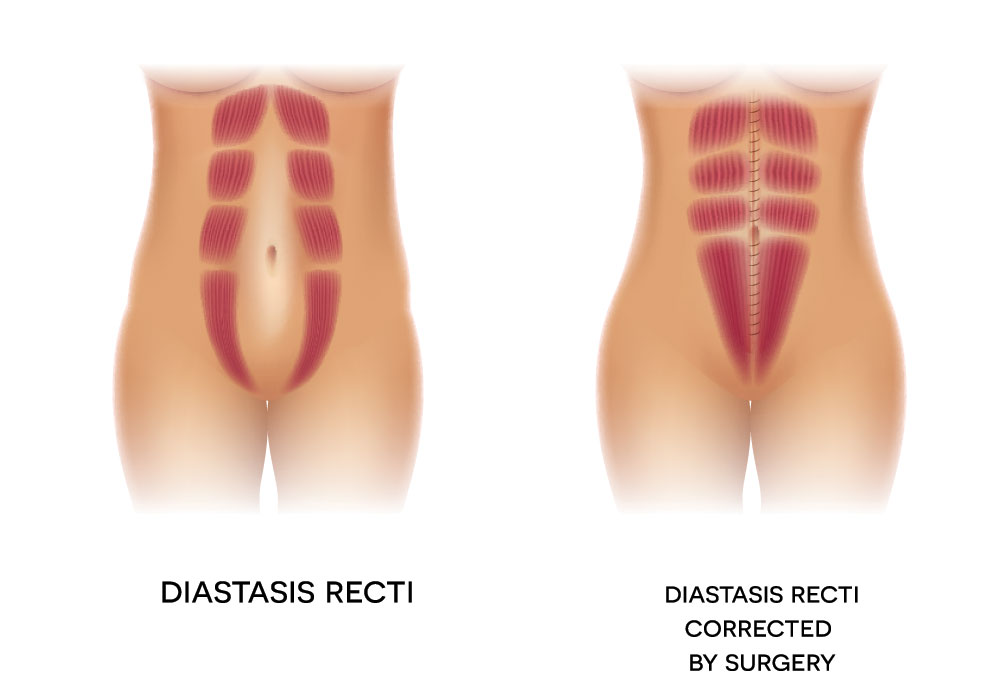


People who find fault with the appearance of their abdominal wall may be bothered by laxity of their skin, the thickness of the fatty layer below their skin, by looseness and weakness of their underlying muscles or by combinations of these features as well.
Those with a thick fatty layer but good skin tone are good candidates for liposuction alone. But when there is laxity of the skin or muscles from prior pregnancies in women or from weight loss in men or women, some sort of tightening procedure must be considered.
There are several types of abdominoplasties namely mini, modified, and full. Before we discuss the various types of abdominoplasties we should mention that some patients can be helped with a procedure even less involved than a mini-abdominoplasty. This is a “scar revision”. Many women who have had Caesarian sections or other gynecologic surgery develop a retracted scar at the pubis, with redundant, loose skin above it. This can be corrected by excising the scar and a small rim of excess skin to allow the new scar to lie flush with the skin surface. This is sometimes done in conjunction with adjacent liposuction.
The average person who requests and is a good candidate for a tummy tuck has loose skin of the entire abdominal wall or only below the umbilicus. There is often “hooded” skin above the umbilicus. The abdominal muscles may also be loose. This is called a “diastasis recti” and refers to the separation of the once side by side linear muscles of the abdominal wall called the rectus muscles.
When the looseness is restricted to the area below the umbilicus we perform a mini-abdominoplasty with or without muscle tightening. The resultant scar is typically a bit longer than the average C-section scar. Often liposuction of the abdominal wall and waist are also done to improve the contour of the entire trunk as much as possible. No drains are used and recovery is about one week. When there is significant looseness of the skin and/or muscles above the umbilicus, a full abdominoplasty must be considered. Supplementary liposuction of the waist and hips is often recommended as well to improve the contour of the entire trunk maximally. This procedure exposes the muscles for tightening from the bottom of the rib cage to the pubis and allows for optimum skin tightening as well. The muscles are tightened with special sutures that absorb over time. A great deal of excess skin is also removed from between the umbilicus and the pubis. It results in a “hip to hip” scar and a circular scar around the umbilicus, but also in a fully rejuvenated and youthful abdominal wall. Most often drains are used and are removed at one week. The average recovery is two weeks. The scars fade over time and are well situated so they can be easily hidden below bathing suits and undergarments.
There is an intermediate procedure called a “modified” abdominoplasty, suited to those with extensive muscle weakness and a modest degree of skin laxity above the umbilicus. In this procedure we detach the umbilicus on its undersurface. This gives us access to repair the muscles completely. We then “float” the umbilicus downward and re-attach it to the muscle. An intermediate amount of skin tightening follows. A drain may be necessary. Recovery is approximately 10-14 days.
A full assessment of the patient’s anatomy by Dr. Sultan and a thorough discussion of their goals with him will allow the correct match of patient to procedure. Gratifying results are sure to follow.
Preparation for any of these procedures includes avoiding medications such as Aspirin, Advil and Motrin for two weeks prior to surgery. The procedures are done under general anesthesia either in our fully accredited office facility or at Mount Sinai West Hospital, depending on patient preference. Long acting anesthetic solutions are used to minimize post-operative pain. Patients are seen within one week of the surgery to remove dressings and sutures and begin showering. Limited exercise may resume one to two weeks after surgery.
